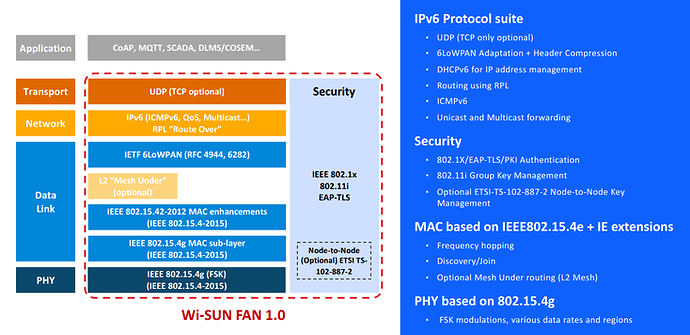Hello Christos,
I wrote a reply email some hours ago but it seems it got lost.
I post the original reply (many topics already covered by the reply of @chrysn ) and also add something regarding the AT86RF2XX series: The at86rf215 is already compatible with WI-SUN.
Could you specify which components are you considering in the netdev driver you describe?
Otherwise, please see inline reply.
On 21/11/25 10:34AM, christos eleftheriadis via RIOT wrote:
Hello all,
As a French ASIC/SoC Design company, Cortus is currently designing a SubGHz SoC for User Equipment.
In this context, Cortus is looking to develop/integrate a full Wi-SUN network stack based on RIOT.
At a first stage, we want to get confirmation about what can be leveraged natively on RIOT to fulfil the Wi-SUN requirements, but also, to point out what is precisely missing.
As an early adopter of RIOT, we are ready to contribute for advancing the RIOT’s state of the art if this Wi-SUN support makes sense for the whole RIOT community.
As a preliminary, you can find below the WI-SUN architecture:
Having WI-SUN support in RIOT makes 100% sense! That sounds promising
and really looking forward to that!
Ideally, we are looking to leverage a maximum number of native components from RIOT, and we came to the following mapping:
- UDP Transport layer → gnrc_udp module
- Network layer → gnrc_ipv6 / gnrc_icmpv6 / gnrc_rpl modules
These layers definitely make sense and can be used for Wi-SUN support.
- Data link layer → gnrc_sixlowpan and gnrc_netif_ieee802154 modules
But we don’t know how far the current gnrc_netif_ieee802154 supports 802.15.4e with IE extensions as listed below:
- Radio Frequency Identification Blink (BLINK)
- Asynchronous multi-channel adaptation (AMCA)
- Deterministic and Synchronous Multi-channel Extension (DSME)
- Low Latency Deterministic Network (LLDN)
- Time Slotted Channel Hopping (TSCH)
- Low Energy (LE)
- Information Elements (IE)
- Enhanced Beacons (EB)
- Multipurpose Frame
- MAC Performance Metrics
- Fast Association (FastA)
From this list, I see a mixture of operation modes, frame types/structure and misc. I will differentiate them and reply one by one. Note that the default RIOT IEEE 802.15.4 support does not implement
association, scanning, roles, etc. They are just “CSMA-CA senders”.
However, we support TSCH via OpenWSN.
Plese refer to this WIP document for more details
Operation modes:
- Radio Frequency Identification Blink (BLINK)
- Asynchronous multi-channel adaptation (AMCA)
- Low Latency Deterministic Network (LLDN)
These ones are not supported.
- Deterministic and Synchronous Multi-channel Extension (DSME)
- Time Slotted Channel Hopping (TSCH)
As mentioned above, TSCH is supported via the OpenWSN package.
We are currently working on porting OpenDSME
into RIOT, so it should also be available in the near future.
Frame types/structure
- Information Elements (IE)
- Enhanced Beacons (EB)
These two are implemented by the packages OpenDSME and OpenWSN, since these
structures are required by DSME and TSCH.
- Multipurpose Frame
AFAIK these are not implemented in RIOT nor provided by any of the IEEE
802.15.4 pkgs.
- MAC Performance Metrics
- Fast Association (FastA)
We have some L2 metrics in RIOT.
Regarding Fast Association, we don’t have support on RIOT.
From our understanding, gnrc_gomach module should support the “Time Slotted Channel Hopping (TSCH)”.
Is that assumption correct ?
No, gnrc_gomach is a different MAC layer
and it’s not part of the IEEE 802.15.4 standard.
- As for the MAC sub-layer can we use dev_ieee802154_submac module, is it 802.15.4g compliant?
Yes, it is 802.15.4 compliant, but note this layer only provides
routines associated to data transmission (CSMA-CA, retransmissions). It
does not implement association, roles, scanning, etc.
- On the security side, we know about the latest introduction of the IEEE 802.15.4 security module. But is that enough to fullfill Wi-SUN security requirements?
Only speaking about the security module, it should suffice. However,
note that this module only provides the encryption scheme.
On the PHY layer, we are using our own netdev driver dedicated to our SoC (which shall remain private) but we are willing to enhance a netdev driver (eg Atmel AT86RF2xx driver) to fully support the specification 802.15.4g and to enable a Wi-SUN capable platform supported by RIOT.
The netdev driver for IEEE 802.15.4 is being replaced by the IEEE
802.15.4 Radio HAL, which
is already used by the SubMAC, OpenWSN and the upcoming port of
OpenDSME. We are currently trying to write bare minimum drivers (just
the transceiver and minimal acceleration) and leave the MAC tasks to the
upper layers (SubMAC, etc). Same as the SubMAC, the IEEE 802.15.4 Radio
HAL was designed to be compatible with the IEEE 802.15.4g.
Before submitting a feature request related to this Wi-SUN support, we would appreciate to get your first feedback in order to clarify and consolidate our project and roadmap.
It would be nice to have a clear picture of the minimal requirements for
Wi-SUN, so we can try to synchronize efforts. Many of the potential
requirements are spread between RIOT code and package support, so we
would definitely need to organize some blocks.
But the whole idea already sounds quite nice!
Cheers,
Thank you in advance,
Christos and @Mattheouus
